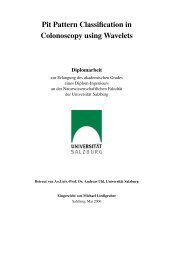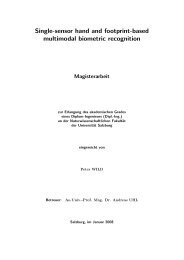A Survey of H.264 AVC/SVC Encryption
A Survey of H.264 AVC/SVC Encryption
A Survey of H.264 AVC/SVC Encryption
Create successful ePaper yourself
Turn your PDF publications into a flip-book with our unique Google optimized e-Paper software.
10Partial encryption schemes that encrypt a subset <strong>of</strong> NALUsare not applicable for content confidentiality as edge imagescan be reconstructed (see figures 10(e), 10(f), and 10(g)).Partial encryption schemes that encrypt the start <strong>of</strong> NALUsmay <strong>of</strong>fer some security with respect to content confidentialityif parts <strong>of</strong> the slice data are encrypted as well, as data iscoded context adaptively (both for CAVLC and CABAC). Incase <strong>of</strong> CAVLC only the coefficient data is coded contextadaptively,and thus at least some coded coefficient data has tobe encrypted. For CAVLC the security relies on the uncertainty<strong>of</strong> the number <strong>of</strong> non-zero coefficients in neighbouring blocks,at most 17x17 combinations (0 to 16 non-zero coefficients)have to be considered for single 4x4 DCT transformed residualblock, not an easy, but solvable task, using back trackingalgorithms that try to correctly decode the partial coefficientdata. For CABAC the security relies on the uncertainty <strong>of</strong>the state <strong>of</strong> arithmetic decoding, which means that the currentstate in decoding (which syntax elements to decode) and thestate <strong>of</strong> each <strong>of</strong> the approximately 400 contexts [52] have tobe guessed, as well as the state <strong>of</strong> the arithmetic decodingvariables codIRange and codIOffset (both represented with 16bit) [27, sect. 9.3.1.2]. Overall a very complex problem anattacker has to solve in order to obtain a partial decoding <strong>of</strong>the slice data. Thus, although there is no formal pro<strong>of</strong> <strong>of</strong> thesecurity <strong>of</strong> this schemes with respect to content confidentiality,a potential adversary is assumed to have a hard time to decodepartially encrypted CABAC encoded video data.2) Security: The preservation <strong>of</strong> the NALU structure andsemantics is considered no security threat, as these data areinsufficient to reconstruct the actual content (visually intelligible).However, an adversary can exploit this source-videodependent length data, which may pose a security threat inpractical application (highly confidential video conferences).3) Compression: There is no or just a negligible influence(due to encryption meta-information, such as cipher algorithm,mode and initialization vectors) on the compression performance.4) Complexity: The cost <strong>of</strong> securely encrypting the videodata is added, i.e., AES encryption which compared to compressionand decompression is small. If NAL compliant encryptionis applied a nearly negligible effort is necessary forsyntax checks.5) Preserved functionality: Format-compliance can only bepreserved if the semantics <strong>of</strong> the NALU are changed, i.e.,the NUT <strong>of</strong> the encrypted data has to be set to a value thatthe decoder ignores the encrypted data. However, if compliantadaptation is a goal the NALU header must not be changed.Thus both compliant adaptation and format-compliant encryptioncan not be achieved at the same time. NALU encryptionwith both schemes preserves the packetization, fast forward,subsequence extraction and scalability. Transcodability andDCT watermarking can not be conducted, but the schemescan be combined with substitution watermarking.C. Sufficient <strong>Encryption</strong>Most proposed schemes are suitable for sufficient encryption<strong>of</strong> <strong>H.264</strong>, the relaxed security requirements make it possibleto employ encryption schemes, that <strong>of</strong>fer functionalities thatwould violate the security requirements <strong>of</strong> other security andapplication scenarios. Contrary to transparent encryption thereis no minimal quality requirement for the cipher video, whichmakes sufficient encryption easier to implement.1) Suitable Video <strong>Encryption</strong> Schemes and ProposedSolutions: For sufficient encryption, a combination <strong>of</strong>compression-integrated encryption schemes is recommended,however, only if additional functionality weights out the disadvantages<strong>of</strong> these schemes in terms <strong>of</strong> security and performance.Also partial encryption schemes that encrypt a subset<strong>of</strong> NALUs (IDR, base layer) can be employed for sufficientencryption. In case <strong>of</strong> <strong>SVC</strong> we propose the encryption <strong>of</strong> thebase layer (see figures 10(f) and 10(g) for replacement attacks,i.e., we have replaced the encrypted picture data by picturescontaining only zero values). If format-compliance is desired,the base layer can be replaced by a uniformly grey videosequence (negligible compression performance deficits).Partial encryption <strong>of</strong> NALUs is an option for sufficientencryption if format-compliance and functionality below theNAL, such as transcodability and DCT watermarking arenot targeted. In the case <strong>of</strong> CAVLC partial decoding is amore realistic threat then in the case <strong>of</strong> CABAC and thusthe application <strong>of</strong> CABAC and the encryption <strong>of</strong> the leadingfraction <strong>of</strong> the NALUs including several bits (>>128) <strong>of</strong> thearithmetically coded data is proposed. In the case <strong>of</strong> CABACthe remaining fraction is hard to decode as all the internalstates <strong>of</strong> the CABAC engine have to be known.2) Security: Security pro<strong>of</strong>s for sufficient encryption arenot found in literature, but successful attacks against previouslyproposed schemes are reported [53]. Due to theapplication <strong>of</strong> unreliable quality metrics for low quality visualdata, e.g., PSNR (peak-signal noise ration) does not performwell for that purpose [58], [20], the result <strong>of</strong> the attacks remainrather incomparable.3) Compression: Compression-integrated encryption <strong>of</strong>tenis associated with a severe reduction <strong>of</strong> compression performance,however, many <strong>of</strong> the proposed schemes for <strong>H.264</strong>perform very well (see table III for an overview).In CAVLC, Intra-PM and MVD are encoded with exponentialGolomb codes, which can be encrypted in a lengthpreserving fashion. Coefficient sign encryption and CAVLCwork well together, in [39] no decrease <strong>of</strong> compression ratiois reported, while a very small decrease <strong>of</strong> compression ratio isreported (a relative file size increase <strong>of</strong> 1% for higher rates 8%for lower rates are reported in [12]). Coefficient permutation ismore expensive (up to 4% for lower rates and 11% for higherrates).4) Complexity: In case <strong>of</strong> an online scenario (compressionis conducted anyways) the complexity <strong>of</strong> compressionintegratedencryption schemes is almost negligible comparedto compression and decompression.In case <strong>of</strong> an <strong>of</strong>fline scenario the compression-integratedencryption schemes require that computationally expensiveparts, such as binary arithmetic decoding have to be performed.Given the relative small cost <strong>of</strong> encryption compared to compressionand decompression these approaches have significantdisadvantages compared to bitstream-based schemes.








